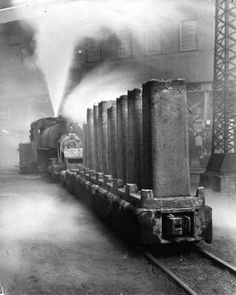
INGOTS
My high school was a lot of things—apathy absorption center, teenage pregnancy retreat, day care for potheads—but it was definitely not academic. No, East Gary High was a glorified vocational school, the kind of place where learning about crescent wrenches was far more important than learning about the Fertile Crescent. Such a reality was not surprising, given the fact that our mascot was an ingot, a huge, ten ton, fifteen foot high, five-foot thick block of molded steel that towered before the front of the school. The ingot looked like a gigantic tombstone, thick and bulky, solid and immovable. Above all, it was utterly featureless, with no distinctive markings whatsoever. It looked like one of the monoliths in 2001: A Space Odyssey, only shorter, fatter, and somehow stupider. It was nothing more than a big block of steel.
A bland, ill-conceived monument to heavy industry, the ingot served as a grim reminder of what the future would be for the zoned out, half aware, Pink Floyd-programmed bodies that roamed the halls of my school. The ingot said in no uncertain terms that we were all faceless blocks, nothing more than automatons stamped out from the same dismal, blue collar mold. An ingot was something processed, one of many in a series of objects that were all shaped exactly the same; an ingot was conformity incarnate. To see it every morning as the bus pulled up was disheartening at best, and even when they painted it a bright crimson red one year, the ingot always looked aloof and out of place, like it had been distanced from its tribe, singled out and put on display unfairly.
Occasionally, the ingot, and the small sign below that read “Home of the Ingots,” looked inviting, like a big friendly slab you could climb up on top of, or whose shadow you could enjoy a sandwich under. But most of the time it looked bulky and at odds with its surroundings. Like it fell off a truck and didn’t belong there, all dolled up, surrounded by flowerbeds and made out to be this special and unique thing, serving as some sort of identity-less identity source for an entire community.
The ingot was supposed to represent strength. To underscore the value of hard work. Ingots were forged with discipline. Ingots were solid and reliable, with unalloyed pride. That’s what the town fathers and school administration probably thought when they conceived our team name back in the Fifties. But as years of attending the school passed by, it became clear to me that the ingot was an emblem of many other qualities that were far more widespread: laziness, ignorance and only the slightest of ambitions. The ingot set the bar nice and low, perfectly positioned for underachievement.
And the fact that, years later, it was eventually replaced by the continuous slab caster, a structure I helped build, which poured molten pig iron from the ladles and transformed it into a long, glowing slabs of newly birthed steel, made the ingot a perfectly ironic metaphor for the decline of steel mill jobs in the entire area.
Keep Shoveling is a memoir depicting my experience as a laborer in U.S. Steel. Bracing, bawdy, and full of seedy, unforgettable characters, it’s a rollicking, whiskey-fueled, warts-and-all coming of age story that confirms that not all of life’s lessons are learned in the classroom.